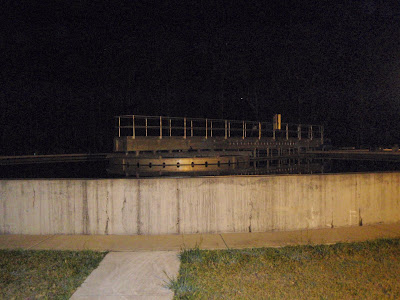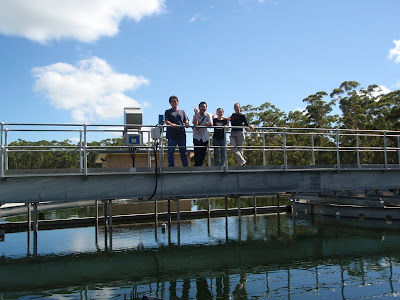One of our research group’s PhD students, ‘Nhat’ is investigating the fate of some antibiotic drugs during biological sewage treatment processes. In doing so, he is comparing how well the drugs are removed during conventional activated sludge treatment with removal by an experimental membrane bioreactor.
Old Bar STP is operated by MidCoast Water, with whom we have an on-going research relationship. So in order to characterise the performance of the STP and simultaneously obtain some useful data for Nhat’s project, we decided to undertake a ‘diurnal investigation’ of the plant.
This means that we monitored the performance of the STP in removing a wide range of chemical contaminants (mainly pharmaceuticals, hormones and pesticides) over a 24-hour period. This can be a useful step in characterizing an STP since a number of factors can change over this diurnal period.
For example, the flow of water into the plant changes according to community sleeping habits. We see a peek flow around 7-8am when people are showering and another later in the evening for bath-time and dishwashing. We have also previously observed that the concentration (and the ‘load’) of pharmaceuticals in sewage changes over 24 hours, presumably as a consequence of factors such as when particular drugs are taken, the rate of metabolism and when people go to the toilet.
We collected samples from the influent to the STP every two hours and samples from the effluents of the activated sludge process and the membrane bioreactor every other hour. Since we were sampling in triplicate, this meant that we had to collect, filter and extract over 100 samples during the 24 hour period.
It will probably take a month to analyse the samples and process the data, so we won’t have any results until then. However, I took the opportunity to take some slightly unusual ‘sewage treatment plant by night’ photographs, which I thought I’d like to share... Who would have guessed that an STP could look so pretty by night!?
 Sampling the untreated sewage influent at 2am
Sampling the untreated sewage influent at 2am Secondary clarifier at night
Secondary clarifier at night The ultraviolet (UV) disinfection system glows by night
The ultraviolet (UV) disinfection system glows by night









2 comments:
Yes Stuart. It is good to have an interest in something.
Bacteria resistant superbugs found in water supply
FLESH-eating bacteria resistant to antibiotics have found their way from hospital sewers into rivers and streams throughout Queensland.
Scientists who made the startling discovery in 2006 have expressed alarm that the State Government failed to follow up their report or act on their recommendations.
Secret tests on waste water discharged from 28 Queensland hospitals and clinics revealed the widespread presence of MRSA (Methicillin resistant Staphylococcus aureus) and VRE (Vancomycin resistant Enterococci).
However there was no evidence the potentially lethal organisms had made their way into drinking water.
A Central Queensland University scientist who helped carry out the research told me 97 per cent of hospital sewage discharge lines tested positive for antibiotic resistant bacteria.
He said 70 per cent of hospital discharges tested positive for both MRSA and VRE.
"We got a lot more of those bacteria than we thought possible," he said.
"The MRSA and VRE are a major source of deaths from medical infections.
"Even though they have passed through a treatment process, the bacteria are most likely getting back into natural waterways, dams and ponds used for swimming, boating, fishing and in food production.
"Strangely, they are not routinely tested in water management systems.
"A sample can come back lacking in, for instance, E. coli bacteria, so it's wrongly assumed it's safe."
The results of the tests were tabled in Parliament by Dr Bruce Flegg (LNP, Moggill) in 2007 but went unreported perhaps due to their technical nature.
The report sat in limbo until it was tabled again last week by Rob Messenger (LNP, Burnett) who asked Health Minister Stephen Robertson to explain why it cost taxpayers $2.6 million when the university got only $107,000 for researching and writing it.
As well as the deadly microbes resistant to antibiotics, the scientists led by William Sinclair, Ben Kele and Barry Hood revealed the presence of 56 chemicals and heavy metals - some highly toxic - in hospital waste water.
The report noted: "The presence of these organisms at the point of wastewater entry into the council sewerage system indicates it is likely they will routinely be washed into the general wastewater stream, which flows to the community treatment facility.
"The fate of these organisms is a primary concern.
"Are they removed from the 'treated' water or do they pass through the treatment process and into the 'treated' outflow?
"If they are retained in the treatment system what happens to them - are they destroyed or do they form part of the microbial community associated with the facility?"
Checks were done at nearly 180 remote and regional hospitals and community health centres and dental clinics.
The hospitals where MRSA or VRE or both were found were listed as Kilcoy, Moura, Yeppoon, Weipa, Charters Towers, St George, Ayr, Emerald, Dalby, Thursday Island, Kingaroy, Boonah, Biloela, Babinda, Texas, Surat, Blackwater, Moranbah, Maleny, Gordonvale, Oakey, Mapoon, Ravenshoe, New Mappoon, Whitsunday and Proserpine.
The university's study is believed to be the first of its kind in Australia.
I understand the findings have been verified by the CSIRO.
The report was completed in 2006 and became the centre of a Crime and Misconduct Commission investigation.
During the investigation the anti-corruption watchdog raided the homes and offices of at least four businessmen with links to the Australian Labor Party.
Shamefully, the report was not released by the State Government and the scientists doubt if any of their recommendations were implemented.
"There was a wall of silence," one scientist said.
"We heard nothing."
Mr Messenger said he was appalled the Health Minister was doing exactly the opposite to what he promised in Parliament by dismissing the issue and sweeping it under the carpet.
In the US, medical journals have likened the arrival of the MRSA "superbug" to the AIDS epidemic.
At a recent conference on infectious diseases in Cairns, the principal scientist at Royal Perth Hospital, Geoffrey Coombs, said MSRA was one of the biggest bacterial threats to humanity.
One of the country's leading water experts assures me Queensland's drinking water is free of dangerous bacteria.
Don Bursill from the National Health and Medical Research Council said although super bugs such as golden staph might be occurring environmentally, they did not survive the drinking water treatment process.
"None of these pathogens which have developed this resistance are surviving in public water supplies," Professor Bursill said.
He was confident the final chlorine and ultraviolet light treatments kept drinking water safe.
http://www.news.com.au/couriermail/story/0,23739,25082622-3102,00.html
Post a Comment